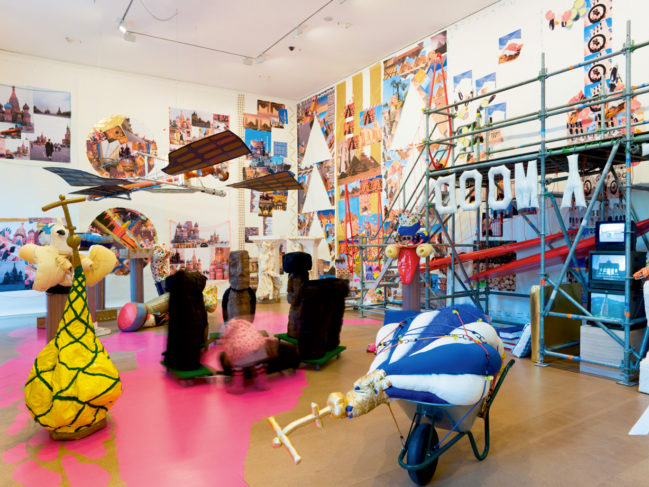
- Source: ART IN AMERICA
- Author: DAVID ULRICHS
- Date: MARCH 28, 2011
- Format: DIGITAL
Agathe Snow
BERLIN at Deutsche Guggenheim

Photo: View of Agathe Snow’s exhibition “All Access World,” 2011; at the Deutsche Guggenheim.
“All Access World,” the 16th exhibition of commissioned work at the Deutsche Guggenheim, offered a full-room installation—the fruits of a three-month Berlin residency—by the Corsican-born Agathe Snow. The New York artist (who was married to the late art-world bad-boy Dash Snow) filled the walls of the exhibition space with large-scale collages on canvas, covered the floor with movable sculptures and installed scaffolding, adorned with an upside-down version of the Hollywood sign, on which viewers could walk.
Reproductions of the world’s most famous landmarks and monuments, both historical and contemporary, taken from various sources, including magazines, postcards and photographs, were glued in riotous configurations onto the ceiling-to-floor canvases. Pictures of the pyramids at Giza, the Eiffel Tower, the Sydney Opera House, the Brandenburg Gate and, rather unsurprisingly, New York’s Guggenheim Museum proliferated throughout the space. Large assemblage sculptures on wheels also contained jumbles of roughly reproduced elements of the aforementioned and other monuments. These could be viewed from atop the rickety scaffolding, and they were randomly exchanged with other such sculptures during the run of the show. Standing on a world map painted on the floor, viewers were encouraged to move the sculptures around.
In addition to the display, Snow has called into life a fictional company bearing the same name as the exhibition’s title. Its stated aim is to provide hybrid monuments made to order, and the exhibition publication resembles a mail-order catalogue. Like the works on view, these “personalized” monuments can contain any number of well-known landmark elements, such as columns from the Acropolis, turrets from St. Basil’s Cathedral in Moscow, stones from Stonehenge, all arranged to the buyer’s taste. All Access World fabricates personalized models of the perfect monument for the everyman.
The exhibition depended upon locations and objects that have entered our collective consciousness through mass reproduction. While perhaps this is a way to bring the politically charged images of certain subjects into the museum, the experience of viewing this outpouring was not unlike looking at a stranger’s holiday snapshots.

